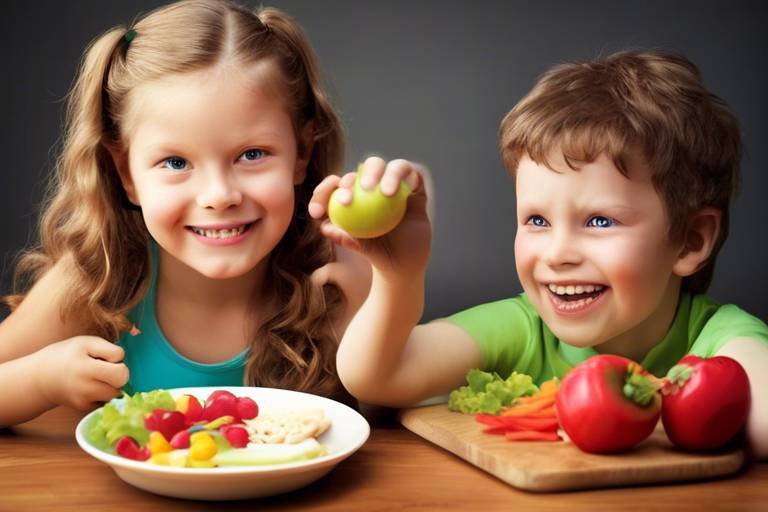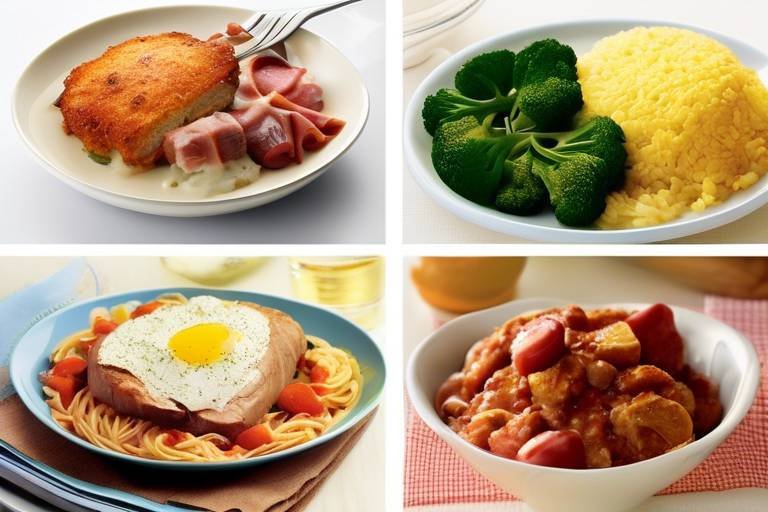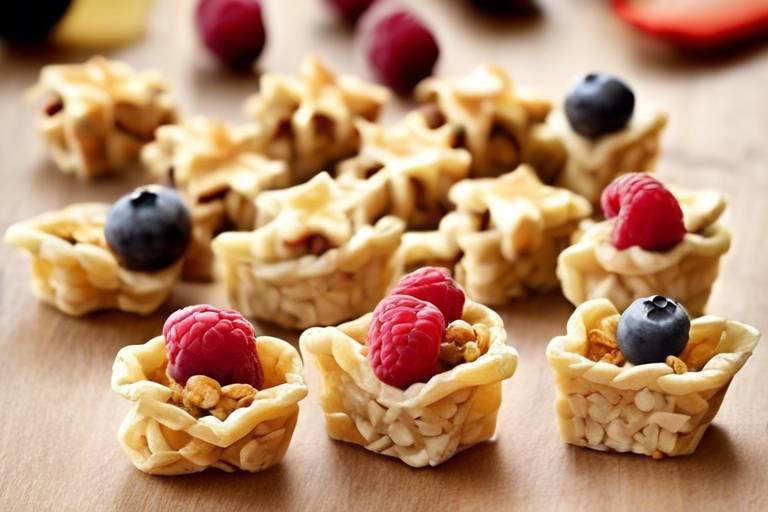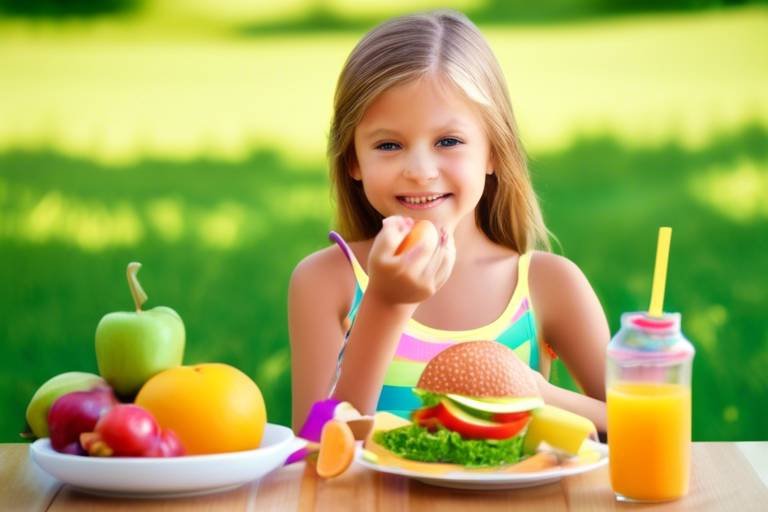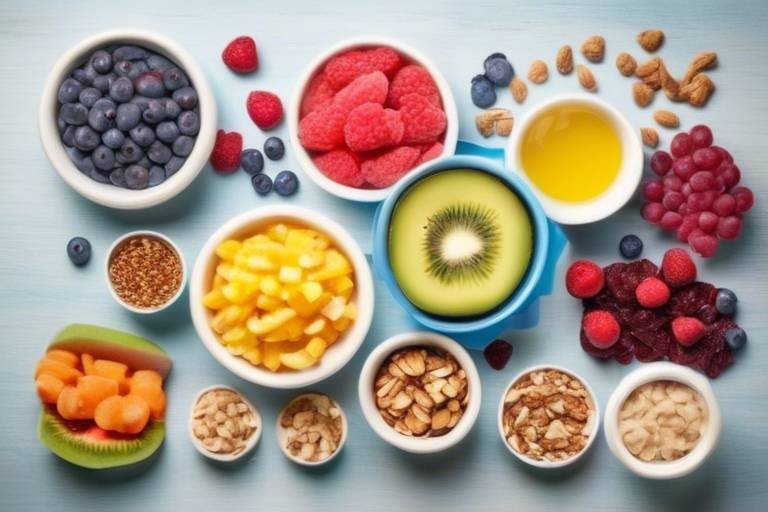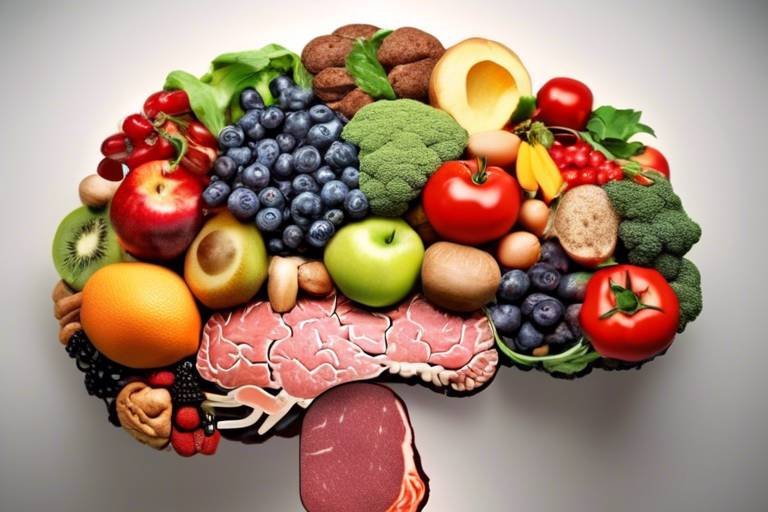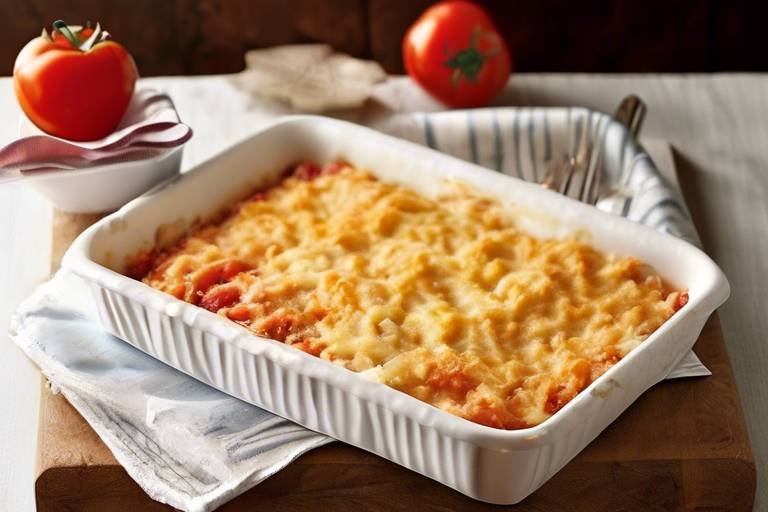A Guide to Nutrition for Active Children
In today's fast-paced world, where children are more active than ever, ensuring they receive the right nutrition is crucial. Active children require a well-balanced diet that supports their growth, energy levels, and overall health. But what does that really mean? It’s not just about stuffing them with food; it’s about providing the right types of food that fuel their bodies and minds. Think of their bodies as high-performance engines that need the best fuel to run smoothly. In this guide, we will explore essential nutritional guidelines tailored for active kids, emphasizing the significance of a balanced diet, hydration, and healthy eating habits.
Understanding balanced nutrition is like having a treasure map that leads to optimal health. For active children, it’s vital to include a variety of food groups that work together to provide the necessary energy and nutrients. Fruits, vegetables, whole grains, proteins, and healthy fats are the building blocks of a nutritious diet. Each group plays a unique role:
- Fruits and Vegetables: Packed with vitamins, minerals, and antioxidants, these help in boosting immunity and overall health.
- Whole Grains: They provide the energy needed for physical activities, ensuring kids can play hard and recover well.
- Proteins: Essential for growth and muscle repair, proteins are crucial for active children.
- Healthy Fats: These support brain development and provide a concentrated source of energy.
By incorporating a variety of foods from these groups, parents can help their children develop a strong foundation for a healthy lifestyle.
Active children require specific nutrients to fuel their bodies effectively. Just like a car needs oil, gas, and a good battery to run, kids need a mix of vitamins, minerals, proteins, and fats. Let’s break it down:
Carbohydrates are the primary source of energy for active children. They are like the gas in a car—without them, the engine just won’t run. Carbs come in two forms: simple and complex. Each type has its own benefits and roles in a child’s diet.
Understanding the difference between complex and simple carbohydrates is essential. Complex carbs, found in foods like whole grains, beans, and vegetables, provide sustained energy, making them ideal for active play. On the other hand, simple carbs, such as those found in candy and sugary drinks, offer a quick burst of energy but can lead to a crash later on. Think of complex carbs as a marathon runner, while simple carbs are sprinters—both have their place, but for endurance, complex carbs are the way to go.
So, how can parents ensure their kids are getting healthy carbohydrates? Here are some practical tips:
- Serve whole grain pasta or brown rice instead of white varieties.
- Add fruits and vegetables to every meal for added fiber and nutrients.
- Incorporate beans and legumes into soups and salads for an extra energy boost.
These small changes can make a big difference in energy levels and overall health.
Protein is another critical component of a nutritious diet for active children. It plays a vital role in growth and muscle repair, helping kids recover after a day of play. Excellent sources of protein include lean meats, fish, eggs, dairy, and plant-based options like nuts and legumes. Think of protein as the construction workers of the body—repairing and building tissues after a hard day of activity.
Proper hydration is essential for active children. Just like a car needs coolant to prevent overheating, kids need water to keep their bodies functioning optimally. Dehydration can lead to fatigue, dizziness, and decreased performance. Parents should be aware of the signs of dehydration, which include:
- Dry mouth
- Dark yellow urine
- Fatigue
- Headaches
Ensuring that children drink enough water throughout the day is crucial, especially during physical activities.
Encouraging children to drink enough fluids can be a challenge. Here are some practical tips:
- Offer water before, during, and after activities.
- Make hydration fun by using colorful bottles or adding slices of fruit to water.
- Set reminders for kids to drink water, especially during playtime.
By instilling good hydration habits early on, parents can help their children stay energized and healthy.
Establishing healthy eating habits early is vital for active children. Parents play a crucial role in promoting nutritious choices and creating a positive food environment at home. This means involving kids in meal planning and preparation, making healthy foods accessible, and being role models for good eating habits. It’s all about creating a culture of health and wellness that kids can carry with them into adulthood.
1. What are the best snacks for active children?
Healthy snacks like fruits, yogurt, nuts, and whole grain crackers are excellent choices that provide energy and nutrients.
2. How much water should my child drink daily?
Children should aim for about 7-8 cups of water per day, more if they are active or in hot weather.
3. Can children get enough protein from a vegetarian diet?
Absolutely! Foods like beans, lentils, tofu, and quinoa are great plant-based protein sources.
4. How can I encourage my child to eat more vegetables?
Involve them in cooking, make veggies fun with dips, or incorporate them into their favorite dishes.

The Importance of Balanced Nutrition
This article explores essential nutritional guidelines tailored for active children, emphasizing the importance of a balanced diet, hydration, and healthy eating habits to support their growth and physical activities.
Understanding balanced nutrition is crucial for active children. Just like a car needs the right fuel to run smoothly, children require a variety of nutrients to support their energy levels, growth, and overall health. A balanced diet is not just about eating fruits and vegetables; it encompasses a mix of different food groups, each playing a vital role in a child’s development. Think of it as a colorful plate, where each color represents a different nutrient that contributes to a child’s well-being.
To paint a clearer picture, let’s break down the key food groups that should be included in a child's diet:
- Fruits and Vegetables: These are packed with vitamins, minerals, and antioxidants that are essential for immune function and overall health.
- Proteins: Vital for growth and muscle repair, proteins can be sourced from meat, fish, eggs, dairy, legumes, and nuts.
- Whole Grains: Providing complex carbohydrates, whole grains are essential for sustained energy, especially for active kids.
- Dairy: Important for bone health, dairy products are rich in calcium and vitamin D.
- Healthy Fats: Sources like avocados, nuts, and olive oil are crucial for brain development and energy.
When these food groups come together, they create a powerhouse of nutrients that can support everything from physical activities to cognitive development. Imagine a young athlete preparing for a big game; their body needs the right mix of carbs for energy, proteins for muscle repair, and fats for endurance. Without these, they might feel sluggish or unable to perform at their best.
In addition to providing energy, a balanced diet helps in maintaining a healthy weight. With childhood obesity on the rise, instilling healthy eating habits early on can set the foundation for a lifetime of good health. Parents and caregivers play a pivotal role in this journey. By offering a variety of nutritious foods and encouraging children to try new things, they can help develop a positive relationship with food.
Moreover, it’s important to make mealtime enjoyable. Family meals can be a great way to introduce new foods and discuss the benefits of healthy eating. When children see their parents enjoying a rainbow of foods, they are more likely to mimic those behaviors. Remember, it’s not just about what they eat, but how they perceive food and nutrition.
In conclusion, balanced nutrition is not merely a checklist of foods to eat; it’s a holistic approach to fueling an active lifestyle. By prioritizing a variety of foods from all the essential groups, parents can ensure their children are not only ready to take on the day but also equipped for a healthier future.
Active children require specific nutrients to fuel their bodies. This section outlines the essential vitamins, minerals, proteins, and fats needed to support their energy levels and overall health.
Carbohydrates are vital for active children as they provide the primary source of energy. This subsection explains the different types of carbohydrates and how they benefit physical activity.
Understanding the difference between complex and simple carbohydrates is essential. This part highlights the benefits of complex carbs for sustained energy versus the quick energy from simple carbs.
This section provides practical tips on how to include healthy carbohydrate sources in children's meals, ensuring they receive adequate energy for their activities.
Protein plays a critical role in growth and muscle repair for active children. This subsection discusses the best sources of protein and their importance in a child's diet.
Proper hydration is essential for active children. This section explores the importance of water, signs of dehydration, and tips for ensuring kids stay hydrated during physical activities.
This subsection offers practical advice on how to encourage children to drink enough fluids, including recommendations on when and what they should drink before, during, and after activities.
Establishing healthy eating habits early is vital for active children. This section discusses strategies for parents to promote nutritious choices and create a positive food environment at home.
Q: What are the best snacks for active children?
A: Healthy snacks like fruit, yogurt, nuts, and whole-grain crackers provide the necessary energy without excess sugar.
Q: How can I encourage my child to drink more water?
A: Make water fun! Use colorful cups, add slices of fruit for flavor, or set reminders during playtime.
Q: Is it okay for my child to have treats?
A: Absolutely! Treats can be part of a balanced diet. The key is moderation and ensuring they don’t replace nutritious foods.

When it comes to fueling the energetic bodies of active children, understanding the essential nutrients they need is paramount. Just like a car needs the right fuel to run smoothly, children require specific nutrients to support their growth, energy levels, and overall health. These nutrients are the building blocks of a balanced diet and play crucial roles in keeping kids active and thriving. So, what exactly do they need?
First and foremost, let's talk about vitamins and minerals. These little powerhouses are vital for numerous bodily functions, from maintaining a strong immune system to supporting bone health. For instance, calcium is essential for growing bones, while iron is crucial for transporting oxygen in the blood. Active children can benefit greatly from a variety of fruits and vegetables, which are packed with these essential nutrients. A colorful plate is not just visually appealing; it’s a sign of a nutrient-rich meal!
Next up is protein, often dubbed the building block of life. For active kids, protein is critical for muscle growth and repair. Think of protein as the construction crew that helps build and fix the muscles that children use during their play and sports activities. Some excellent sources of protein include lean meats, poultry, fish, eggs, dairy products, beans, and nuts. Incorporating these foods into meals can help ensure that kids are getting the protein they need to stay strong and active.
And we can't forget about healthy fats. While some may shy away from fats, they are essential for brain development and overall health. Healthy fats, such as those found in avocados, nuts, and olive oil, provide energy and help absorb vital vitamins. Think of fats as the lubricant that keeps everything running smoothly in the body. So, don’t hesitate to add a drizzle of olive oil over a salad or toss some nuts into a snack mix!
Now, let’s break down the energy sources a bit more with a quick look at carbohydrates. These are the primary energy source for active kids. Carbs can be divided into two main categories: complex carbohydrates and simple carbohydrates. Complex carbs, such as whole grains, fruits, and vegetables, provide sustained energy, making them ideal for fueling longer activities. On the other hand, simple carbs, like those found in candy and sugary drinks, offer quick bursts of energy, but can lead to crashes later on. It's crucial to strike a balance between these two types of carbohydrates to keep energy levels steady throughout the day.
To summarize, here’s a quick table showcasing the essential nutrients and their benefits for active kids:
| Nutrient | Benefits | Sources |
|---|---|---|
| Vitamins & Minerals | Support immune function, bone health, and overall growth | Fruits, vegetables, dairy, nuts |
| Protein | Muscle growth and repair | Meat, fish, eggs, beans, nuts |
| Healthy Fats | Brain development, energy, absorption of vitamins | Avocados, nuts, olive oil |
| Carbohydrates | Primary energy source | Whole grains, fruits, vegetables |
In conclusion, ensuring that active children receive a well-rounded diet rich in essential nutrients is key to supporting their growth and physical performance. By focusing on a variety of foods that provide the necessary vitamins, minerals, proteins, healthy fats, and carbohydrates, parents can help their kids stay energetic, healthy, and ready for any adventure that comes their way!
Q: How can I ensure my child is getting enough nutrients?
A: Offering a variety of foods from all food groups is essential. Focus on colorful fruits and vegetables, whole grains, lean proteins, and healthy fats. Make mealtime fun and engaging to encourage your child to try new foods.
Q: What are some quick snack ideas for active kids?
A: Great snack options include yogurt with fruit, nut butter on whole-grain toast, trail mix with nuts and dried fruits, or veggie sticks with hummus. These snacks are nutritious and provide the energy kids need!
Q: How important is hydration for active children?
A: Hydration is crucial! Encourage your child to drink water throughout the day, especially before, during, and after physical activities. Dehydration can lead to fatigue and decreased performance.

When it comes to fueling the bodies of active children, carbohydrates are the unsung heroes. Imagine a car running on empty; without fuel, it simply won't go. Similarly, children engaged in physical activities need a steady supply of energy to keep them moving, learning, and playing. Carbohydrates serve as the primary source of energy for young athletes, making it essential for parents to understand the different types and their benefits.
Carbohydrates can be categorized into two main types: simple carbohydrates and complex carbohydrates. Simple carbs, found in sugary snacks and drinks, provide a quick burst of energy. However, this energy often fades just as fast, leaving kids feeling sluggish. In contrast, complex carbohydrates, which are found in whole grains, fruits, and vegetables, offer sustained energy that can last throughout the day. Think of complex carbs as a reliable friend who always has your back, providing energy when you need it most!
Incorporating healthy carbohydrates into a child's diet can be both fun and delicious. For instance, consider a colorful plate filled with brown rice, sweet potatoes, and a variety of fruits. Not only does this combination provide essential nutrients, but it also makes meals visually appealing, encouraging children to eat healthily. Here are some practical tips to ensure kids are getting the right kind of carbs:
- Opt for whole grain options like brown bread and whole grain pasta.
- Include a variety of fruits and vegetables in their meals and snacks.
- Experiment with different recipes that highlight healthy carbs, like quinoa salads or oatmeal cookies.
It’s also important to educate children about the benefits of carbs. When they understand that these foods help them run faster, jump higher, and play longer, they are more likely to make healthier choices. Encouraging kids to choose snacks like fruit, yogurt with granola, or whole grain crackers can make a significant difference in their energy levels during playtime.
In summary, carbohydrates are not just another part of a child's diet; they are the fuel that powers their active lives. By focusing on providing a balance of simple and complex carbs, parents can help their children maintain energy levels, enhance performance, and enjoy a healthy lifestyle. Remember, the right fuel can make all the difference in how children feel and perform, both on and off the field!
Q1: How many carbohydrates should active children consume daily?
A: The amount of carbohydrates varies based on age, sex, and activity level, but generally, they should make up about 45-65% of total daily calories. Consulting with a pediatric nutritionist can provide personalized recommendations.
Q2: Are all carbohydrates created equal?
A: No, they are not! Simple carbohydrates can lead to quick energy spikes but may not provide lasting benefits. Complex carbohydrates are generally healthier as they offer sustained energy and are packed with nutrients.
Q3: What are some good sources of complex carbohydrates?
A: Excellent sources include whole grains (like brown rice and quinoa), legumes (like beans and lentils), fruits, and vegetables. These foods not only provide energy but also essential vitamins and minerals.
Q4: How can I encourage my child to choose healthier carbohydrate options?
A: Involve your child in meal planning and preparation, and make healthy carbs appealing by presenting them in fun and creative ways. Educate them about the benefits of these foods to empower their choices.

When it comes to fueling active children, understanding the difference between complex and simple carbohydrates is crucial. Think of carbohydrates as the body's main source of energy, much like gasoline is for a car. Just as you wouldn’t want to put low-quality fuel into your vehicle, your kids need the right kind of carbs to keep them energized and ready for action!
Simple carbohydrates are like a quick burst of energy. They are found in foods such as candy, sugary drinks, and baked goods. These carbs are digested rapidly, leading to a swift spike in blood sugar levels. While this might sound great for a quick energy boost, it often results in a crash that can leave kids feeling tired and irritable shortly after. Imagine a firework that lights up the sky for just a moment before fading away – that’s the effect simple carbs can have on energy levels.
On the other hand, complex carbohydrates are your child’s best friend for sustained energy. These are found in whole grains, legumes, fruits, and vegetables. Unlike simple carbs, complex carbs take longer to digest, providing a steady release of energy that can keep kids fueled throughout their activities. Think of complex carbs as a slow-burning fire that keeps the warmth going for hours, rather than a firework that fizzles out quickly.
To help you understand better, here’s a quick comparison:
| Type of Carbohydrate | Examples | Energy Release | Health Benefits |
|---|---|---|---|
| Simple Carbohydrates | Sugary snacks, sodas, white bread | Quick spike, followed by a crash | Minimal nutritional value |
| Complex Carbohydrates | Brown rice, whole grain bread, quinoa | Steady release | Rich in fiber, vitamins, and minerals |
Incorporating more complex carbohydrates into your child's diet can lead to better overall health and improved athletic performance. Encourage them to choose whole grain options, enjoy a variety of fruits and vegetables, and include legumes in their meals. This way, you’re not just filling their plates; you’re fueling their bodies for success!
In summary, while simple carbohydrates might tempt kids with their sweet taste and quick energy, complex carbohydrates are the true champions of sustained energy and nutrition. By making informed choices about the types of carbs your children consume, you can help them stay active, focused, and ready to take on whatever challenges come their way!
- What are some good sources of complex carbohydrates? Good sources include whole grains like brown rice and oats, legumes such as beans and lentils, and plenty of fruits and vegetables.
- Can simple carbohydrates be part of a healthy diet? Yes, but they should be consumed in moderation. It's best to limit sugary snacks and drinks, opting for healthier alternatives most of the time.
- How can I encourage my child to eat more complex carbs? Make meals fun by involving them in the cooking process, and try incorporating complex carbs in creative ways, like adding beans to soups or using whole grain pasta in their favorite dishes.

When it comes to fueling active children, incorporating healthy carbohydrates into their meals is not just a good idea; it's essential! Carbohydrates are the body's primary source of energy, especially for kids who are constantly on the go. But how do we ensure that the carbs they consume are not just empty calories? It’s all about making smart choices and creating a balanced plate that keeps them energized and satisfied.
First off, let’s talk about the types of carbohydrates. Instead of reaching for sugary snacks or white bread, opt for whole grains, fruits, and vegetables. These options provide not only energy but also essential nutrients and fiber that are crucial for digestion and overall health. For instance, swapping out white rice for brown rice or white pasta for whole grain pasta can make a significant difference. Not only do these whole grain options offer a more sustained energy release, but they also keep kids feeling fuller for longer.
Another great way to incorporate healthy carbs is through creative meal planning. For breakfast, consider oatmeal topped with fresh fruits like bananas or berries, which not only adds natural sweetness but also vitamins and antioxidants. Lunch can include a colorful wrap filled with lean proteins, plenty of veggies, and a whole grain tortilla. Dinner? Think about quinoa salad with mixed vegetables and a drizzle of olive oil for a delicious and nutritious end to the day.
To make it easier for parents, here are some practical tips on how to include healthy carbohydrates in children’s meals:
- Mix and Match: Combine different sources of healthy carbs. For example, pair brown rice with black beans and corn for a nutrient-dense meal.
- Snack Smart: Choose snacks like whole grain crackers with hummus or apple slices with almond butter instead of chips or cookies.
- Get Creative: Use fruits in unexpected ways, such as adding mashed bananas to pancakes or using applesauce in baking.
Don’t forget about the importance of involving children in the cooking process! When they help prepare their meals, they’re more likely to be excited about eating them. Plus, it’s a fantastic opportunity to teach them about healthy eating habits and the benefits of nutritious foods. Encourage them to pick out their favorite fruits or grains at the grocery store, or let them help with simple tasks in the kitchen. This hands-on approach not only makes mealtime fun but also empowers them to make healthier choices as they grow.
In conclusion, incorporating healthy carbohydrates into meals for active children is all about making informed choices and getting a bit creative in the kitchen. By focusing on whole grains, fruits, and vegetables, you can provide the energy they need to thrive while also instilling lifelong healthy eating habits. Remember, every little change counts, and your efforts will set the foundation for their nutritional future!

When it comes to the health and vitality of active children, protein is a superstar nutrient that cannot be overlooked. As kids engage in sports, play, and various physical activities, their bodies require ample protein to support not just their growth but also the repair of muscles that undergo stress and strain. Think of protein as the building blocks of the body, essential for creating new cells and repairing damaged ones. Just like a construction crew needs bricks to build a sturdy house, our bodies need protein to build strong muscles and tissues.
So, what exactly makes protein so crucial for our little athletes? First off, protein helps in the development of lean muscle mass, which is vital for any child who is active. It provides the necessary amino acids that serve as the foundation for muscle growth. Without adequate protein, children may struggle to recover from physical exertion, leading to fatigue and decreased performance in their activities. Imagine trying to run a race with a flat tire; that’s what it feels like for kids who are not getting enough protein!
There’s a wide variety of protein sources available, making it easier than ever for parents to incorporate this vital nutrient into their children’s diets. Animal-based proteins such as chicken, fish, eggs, and dairy products are excellent choices, as they contain all the essential amino acids needed for optimal growth. On the other hand, plant-based proteins like beans, lentils, tofu, and nuts are also great options, especially for vegetarian families. Here’s a quick comparison of different protein sources:
| Protein Source | Type | Protein Content (per 100g) |
|---|---|---|
| Chicken Breast | Animal | 31g |
| Salmon | Animal | 25g |
| Eggs | Animal | 13g |
| Lentils | Plant | 9g |
| Chickpeas | Plant | 19g |
| Almonds | Plant | 21g |
To ensure that children are receiving enough protein, parents can aim to include a source of protein in every meal. For breakfast, think about scrambled eggs or Greek yogurt topped with nuts. Lunch could feature a turkey sandwich or a hearty lentil salad, while dinner might include grilled chicken or a delicious stir-fry with tofu. Snacks can also be protein-packed—consider hummus with veggies or cheese slices with whole-grain crackers.
In conclusion, prioritizing protein in an active child's diet is essential for their growth, muscle repair, and overall health. By understanding the importance of this nutrient and incorporating a variety of protein sources, parents can help their children thrive both on and off the field. Remember, a well-nourished child is a happy and energetic child!

When it comes to keeping active children performing at their best, hydration is just as crucial as nutrition. Think of water as the fuel that powers their little engines. Kids are naturally energetic and often engaged in activities that make them sweat, whether it’s running around at the playground or playing a sport. That's why ensuring they stay properly hydrated is vital for their overall health and performance.
So, what does proper hydration look like? First off, it’s essential to understand that children may not always recognize when they are thirsty. This can lead to dehydration, which can negatively impact their energy levels, concentration, and even their mood. Signs of dehydration can include dry mouth, fatigue, dizziness, and irritability. As a parent or caregiver, it’s important to be proactive in encouraging kids to drink water throughout the day, especially before, during, and after physical activities.
To make hydration more appealing, consider incorporating a variety of hydrating foods into their diet. Fruits and vegetables like watermelon, cucumbers, oranges, and strawberries not only provide essential nutrients but also contribute to overall fluid intake. You can even create fun snacks, such as fruit popsicles or smoothies, that are both delicious and hydrating!
Here are some tips to keep in mind for ensuring your little ones stay hydrated:
- Set a Schedule: Encourage your children to drink water at regular intervals. For example, they could have a glass of water with every meal and snack.
- Make It Fun: Use colorful cups or fun straws to make drinking water more exciting. You can also let them choose their own water bottles.
- Lead by Example: Children often mimic their parents’ behaviors, so make sure you’re staying hydrated too!
Moreover, during physical activities, it’s advisable for kids to drink water every 20 minutes. If they’re exercising intensely or for extended periods, consider offering a sports drink that contains electrolytes to help replenish lost minerals. However, it’s crucial to choose options with low sugar content to avoid unnecessary calories.
To summarize, keeping kids hydrated is a simple yet essential part of their daily routine. By being attentive to their hydration needs and making it a fun and regular part of their lives, you can help them stay energized and ready for whatever adventures come their way!
Q: How much water should my child drink daily?
A: It varies by age, activity level, and climate, but a general guideline is about 7-10 cups of fluids per day for children, including water and other beverages.
Q: What are the signs of dehydration in children?
A: Look for symptoms like dry mouth, fatigue, dizziness, and decreased urine output. If your child shows any of these signs, encourage them to drink fluids immediately.
Q: Are sports drinks necessary for kids?
A: Sports drinks can be beneficial during prolonged or intense activities, but they should be used sparingly due to their sugar content. Water is usually sufficient for most activities.
Q: Can fruits and vegetables help with hydration?
A: Absolutely! Many fruits and vegetables have high water content and can contribute significantly to your child's hydration levels.

Keeping kids hydrated is not just about quenching thirst; it's about fueling their bodies for optimal performance and growth. As parents, it’s vital to instill good hydration habits early on. So, how do we ensure our active children are getting enough fluids? First, it’s essential to understand that children often don’t recognize their thirst until they are already dehydrated. This is where proactive measures come into play.
One effective strategy is to encourage children to drink water regularly throughout the day, not just during physical activities. Setting specific times for hydration, such as before meals and snacks, can help establish a routine. For instance, you might say, “Let’s drink a glass of water before we have lunch!” This simple practice can help them develop a habit of drinking water consistently.
Additionally, during physical activities, it’s crucial to remind kids to take hydration breaks. Whether they are playing soccer, running, or just having fun outdoors, a quick drink of water every 20-30 minutes can make a significant difference. It’s also important to consider the type of fluids they are consuming. While water is the best choice, especially for hydration, sometimes children might need a little flavor to entice them to drink more.
Here are some tips to make hydration more appealing:
- Infuse water with fruits: Adding slices of lemon, berries, or cucumber can make water more exciting.
- Use fun containers: Letting kids pick their own water bottles can motivate them to drink more.
- Make it a game: Challenge them to drink a certain amount of water each day and reward them for reaching their goals.
Moreover, understanding the signs of dehydration is crucial. Kids may experience symptoms like dry mouth, fatigue, or irritability when they are not drinking enough. If you notice these signs, it’s time to encourage them to hydrate immediately. A simple way to monitor their hydration levels is by checking the color of their urine; light yellow typically indicates good hydration, while dark yellow suggests they need to drink more fluids.
Finally, it’s essential to educate children about the importance of hydration. Explain to them how staying hydrated helps their bodies function better, keeps their energy levels up, and improves their concentration. When kids understand the “why” behind these practices, they are more likely to embrace them.
In summary, establishing healthy hydration practices is key to supporting the active lifestyles of children. By encouraging regular water intake, making hydration fun, and educating them about its importance, we can help our kids thrive both physically and mentally.
Q: How much water should my child drink each day?
A: The general recommendation is about 7-10 cups of water a day for children, but this can vary based on their age, activity level, and climate.
Q: Is it okay for my child to drink sports drinks?
A: Sports drinks can be beneficial during intense or prolonged physical activities, but they often contain sugar. Water is usually the best option for everyday hydration.
Q: What are the signs my child is dehydrated?
A: Look for symptoms like dry mouth, fatigue, dark urine, and dizziness. If you notice these signs, encourage them to drink water immediately.
Q: Can fruits and vegetables help with hydration?
A: Absolutely! Many fruits and vegetables, like watermelon and cucumbers, have high water content and can contribute to your child's overall hydration.

Establishing healthy eating habits early in life is essential for active children. Just like planting a seed in fertile soil, nurturing good dietary practices can lead to a flourishing future filled with vitality and strength. Children are like sponges; they absorb everything around them, including the eating behaviors modeled by their parents and caregivers. Therefore, it’s crucial to create a positive food environment at home that encourages nutritious choices and fosters a love for healthy foods.
One effective strategy is to involve children in the meal preparation process. When kids help out in the kitchen, they become more interested in the food they eat. It’s like giving them a backstage pass to the culinary world! Whether they are washing vegetables, mixing ingredients, or even setting the table, this involvement can spark curiosity and enthusiasm about healthy eating. Plus, it can turn meal times into a fun family activity rather than just a routine chore.
Another important aspect is to offer a variety of foods. Children are more likely to try new things if they see a colorful array of fruits, vegetables, and whole grains on their plates. Think of it as a rainbow of health! Incorporating different colors and textures can make meals visually appealing and exciting. You might even consider creating a “food adventure” night where the family tries foods from different cultures. This not only broadens their palate but also teaches them about diversity and nutrition.
Consistency is key when it comes to establishing healthy eating habits. Setting regular meal and snack times can help children develop a routine, making it easier for them to understand when to eat and what to expect. It’s important to balance meals with a mix of proteins, carbohydrates, and fats. For instance, a well-rounded breakfast could include whole-grain toast, scrambled eggs, and a piece of fruit. This combination provides energy and essential nutrients to kick-start their day.
Additionally, parents should aim to be role models in their eating habits. Children often mimic the behavior of adults, so if they see their parents enjoying a variety of healthy foods, they are more likely to follow suit. It’s like a game of follow the leader, but in this case, the leader is setting a path toward better health.
Finally, it's crucial to educate children about the benefits of healthy eating. Simple explanations about how certain foods help them grow strong or give them energy for play can make a big difference. For example, telling them that carrots can help them see better in the dark or that milk builds strong bones can make the idea of eating these foods more appealing. This knowledge empowers them to make healthier choices themselves, fostering independence and confidence in their dietary decisions.
In summary, developing healthy eating habits in children is a multifaceted approach that involves engagement, variety, consistency, role modeling, and education. By implementing these strategies, parents can help their children cultivate a positive relationship with food that lasts a lifetime.
- How can I encourage my child to try new foods? Involve them in cooking, offer a variety of options, and make it fun by turning it into a game or adventure.
- What are some healthy snack options for active kids? Fresh fruits, yogurt, whole-grain crackers, and veggie sticks with hummus are great choices.
- How can I make meal times more enjoyable? Create a family tradition around meal times, such as theme nights or cooking together, to make it a fun experience.
- What should I do if my child refuses to eat healthy foods? Be patient and keep offering them without pressure. Sometimes it takes multiple exposures for children to accept new foods.
Frequently Asked Questions
- What is balanced nutrition for active children?
Balanced nutrition for active children means providing a variety of foods from all the essential food groups. This includes carbohydrates, proteins, fats, vitamins, and minerals that together support their growth, energy needs, and overall health. Think of it as building a strong foundation for a house; without each component, the structure can’t stand tall!
- How do carbohydrates benefit active kids?
Carbohydrates are like fuel for a car; they give active kids the energy they need to run, jump, and play. They are the primary source of energy, especially during physical activities. Complex carbohydrates, like whole grains and fruits, provide sustained energy, while simple carbs, like sugary snacks, offer quick bursts of energy. Finding the right balance is key!
- What role does protein play in a child's diet?
Protein is essential for growth and muscle repair, especially for kids who are active. It’s like the building blocks for their bodies! Good sources include lean meats, dairy, beans, and nuts. Ensuring they get enough protein helps them recover from activities and supports their overall development.
- How can I tell if my child is dehydrated?
Signs of dehydration in kids can include dry mouth, fatigue, dizziness, or dark-colored urine. Keeping an eye on these signs, especially during hot weather or after exercise, is important. If they’re feeling thirsty, that’s a clear signal that they need to drink up!
- What are some tips for keeping kids hydrated?
Encouraging kids to drink water regularly is crucial! You can make it fun by offering colorful water bottles or adding slices of fruit for flavor. Remind them to drink before, during, and after activities. Setting a routine, like drinking a glass of water with every meal, can also help keep hydration levels up.
- How can I promote healthy eating habits in my children?
Creating a positive food environment at home is essential. Involve your kids in meal planning and preparation, making it a fun family activity. Offer a variety of healthy options and encourage them to try new foods. Remember, kids learn by example, so be a role model by making nutritious choices yourself!

